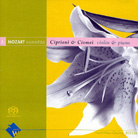October 2004
 This is a Mozart played with real passion. On this hybrid stereo SACD,
Mozart’s music is portrayed with a zest for life and an understanding of the
realities of life that Mozart drew on in creating his masterpieces. The works recorded
here were all written between 1778 and 1781, when Mozart was ages 22 to 25. Beginning with
the "Sonata in Eb" (KV 302), and closing with "Twelve Variations in
G on the French song ‘La Bergere Celimene’" (KV 374a), this disc is a
testament to Mozart’s enduring genius. This is a Mozart played with real passion. On this hybrid stereo SACD,
Mozart’s music is portrayed with a zest for life and an understanding of the
realities of life that Mozart drew on in creating his masterpieces. The works recorded
here were all written between 1778 and 1781, when Mozart was ages 22 to 25. Beginning with
the "Sonata in Eb" (KV 302), and closing with "Twelve Variations in
G on the French song ‘La Bergere Celimene’" (KV 374a), this disc is a
testament to Mozart’s enduring genius.
Fabrizio Cipriani and Sergio Ciomei have been playing together since they were children and musical pals in the Italian city of Genoa. All those years of camaraderie are evident on this disc. They work as one, aware of each other at every turn. The sound captured on this SACD by Northwest’s Oscar Meijer is 100% superb. The sensation of Messrs. Cipriani and Ciomei playing their violin and fortepiano, respectively, in your listening room, especially on the high-resolution layer, is wonderfully captured. Both instruments are placed within the space between your speakers, making the fortepiano a full-sized instrument, with the violin placed just behind the keyboard. The CD layer is fine, a worthy addition to any classical library. But the stereo SACD layer really brings both the sense of the recording's venue and the tonal quality of the instruments more fully alive. A point of interest is the information given regarding the instruments themselves. Cipriani plays a copy of Paganini’s Guarneri Del Jeso violin built in 1997. Ciomei plays two different fortepianos. One (tracks 1-10) is an anonymous 1785 model, and the other (tracks 11-29) is a Salvatore LaGrassa 1815 model. Northwest makes some highly interesting, thought-provoking points regarding the playing of classical music "authentically," and the musicians play in what they term "Living Authenticity" (check out the liner notes for a fuller explanation). Whatever your own point of view on this subject is, I doubt you’ll find much of anything to fault with this recording. GO BACK TO: |
 Mozart - Sonatas For Violin &
Piano
Mozart - Sonatas For Violin &
Piano